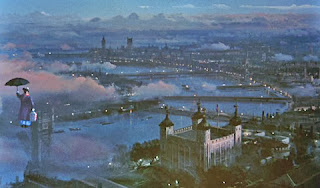Mary Poppins (1964)
The first known matte painting was created by Norman Dawn in 1907, and was a painting on glass for the movie Mission of California. There have now been so many films that add this technique in nowadays that its hard to tell where its used and whats actually real. The more traditional and probably most well known matte paintings include The Wizard of Oz when Dorothy approaches the Emerald City and then also the bottomless tractor-beam in Star Wars Episode IV: A New Hope. Since then probably one of the most notable, but maybe not well known, is the scene from the end of Spielberg's Raider's of the Lost Ark (1981).
Raider's of the Lost Ark (1981)
Throughout the 1990s, traditional matte painting are still used today but often more with digital compositing as well. Die Hard 2 was the first film to use digital composited action footage alongside traditional glass matter painting, which was used for the last scene on the airport runway. Along with this there was even later usage of matte paintings in James Cameron's, Titanic 1997. Painting techniques have now been improved dramatically in the way that 3D models and drawing tablets are now used to create the background for films and they can be then manipulated with a 3D camera to get to all angles of it.
For my video I could use a matte painting for the very background of my film as this is an area that will need to include a lot of detail but then also be able to move around it and interact with it is I need to.
Return of the Jedi (1983)



No comments:
Post a Comment